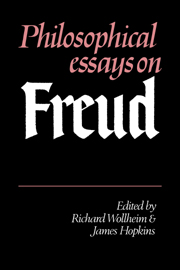Book contents
- Frontmatter
- Contents
- Introduction: philosophy and psychoanalysis
- 1 Conversations on Freud; excerpt from 1932–3 lectures
- 2 Freud, Kepler, and the clinical evidence
- 3 Critical empiricism criticized: the case of Freud
- 4 Freudian commonsense
- 5 Disposition and memory
- 6 On Freud's doctrine of emotions
- 7 The id and the thinking process
- 8 The bodily ego
- 9 Norms and the normal
- 10 On the generation and classification of defence mechanisms
- 11 Models of repression
- 12 Mauvaise foi and the unconscious
- 13 Self-deception and the ‘splitting of the ego’
- 14 Freud's anthropomorphism
- 15 Freud's anatomies of the self
- 16 Motivated irrationality, Freudian theory and cognitive dissonance
- 17 Paradoxes of irrationality
- Works of Freud cited
- Select bibliography
7 - The id and the thinking process
Published online by Cambridge University Press: 01 October 2009
- Frontmatter
- Contents
- Introduction: philosophy and psychoanalysis
- 1 Conversations on Freud; excerpt from 1932–3 lectures
- 2 Freud, Kepler, and the clinical evidence
- 3 Critical empiricism criticized: the case of Freud
- 4 Freudian commonsense
- 5 Disposition and memory
- 6 On Freud's doctrine of emotions
- 7 The id and the thinking process
- 8 The bodily ego
- 9 Norms and the normal
- 10 On the generation and classification of defence mechanisms
- 11 Models of repression
- 12 Mauvaise foi and the unconscious
- 13 Self-deception and the ‘splitting of the ego’
- 14 Freud's anthropomorphism
- 15 Freud's anatomies of the self
- 16 Motivated irrationality, Freudian theory and cognitive dissonance
- 17 Paradoxes of irrationality
- Works of Freud cited
- Select bibliography
Summary
Introduction
The concept of the id was formulated by Freud in 1923, in a work entitled The Ego and the Id, and it marked the culmination of almost thirty years of empirical investigation and meta-psychological thought concerning the unconscious part of the mind. It is remarkably similar to concepts found in the nineteenth-century German philosophical movement, most especially to Shopenhauerian Will and the Dionysiac of the early Nietzsche; indeed, we must in some sense accept that those two great explorers of the mind had stumbled upon the truth of the id. But I think we can, in addition, discern significant likenesses between the Freudian id and concepts ranging as far afield as the Lockean material substratum and the Kantian noumenon.
It is important to notice the sharp distinction which Freud drew – though not perhaps in so many words – between a part of and a system within the mind. The id, in Freudian theory, is the mental system that is the repository of the two ultimate instincts, the life and death instincts, Eros and Thanatos. Then while these instinctual contents of the id are in themselves invariably unconscious, so that an entry on their part into consciousness would be possible only in symbolic form, the Freudian concept of the unconscious is not the concept of a particular mental system like the id.
- Type
- Chapter
- Information
- Philosophical Essays on Freud , pp. 106 - 123Publisher: Cambridge University PressPrint publication year: 1982



